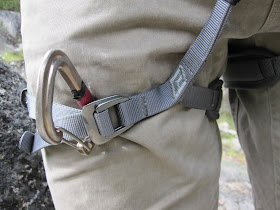I recently was shocked to find a somewhat major problem with my brand new harness. I bought a harness with "fast-buckle" systems. These systems have been around for five years or so, but are becoming an increasingly popular system on harnesses. The fast-buckle is essentially a system that allows you climb into your harness and tighten it up. You don't need to double it back or anything, once it's been tightened, it's supposedly good.
I've always been concerned that these harnesses might cause people to forget to double themselves back if they use a "normal" harness after using a fast-buckle for a period of time. But such a concern is nowhere near as disturbing as what I found when playing with my new fast-buckle harness.
I discovered that the leg-loop can actually unbuckle itself if you clip your rappel back-up friction-hitch directly into it near the buckle. See the following picture for what not to do with your carabiner on your leg-loop.
 Note the location of the carabiner on the buckle. If you actually had to use a rappel back-up
Note the location of the carabiner on the buckle. If you actually had to use a rappel back-upclipped to this carabiner, it could potentially cause the buckle to release. Do not do this.
The best thing to do with the friction-hitch back-up in order to avoid an unintentional unbuckling, is to clip it to the leg-loop near the crotch. The strap that goes up to the belay-loop will isolate the carabiner from the buckle and will not allow it to unbuckle.
 A climber set up to rappel properly with the carabiner to the back-up friction-hitch
A climber set up to rappel properly with the carabiner to the back-up friction-hitchclipped near the crotch.
Every new piece of equipment has a few bugs to work out and the fast-buckle harnesses are no exception. The problem is that a lack of knowledge on this particular issue could lead to an injury or a fatality. So spread the word far and wide. This is a great invention, but it's really only great if everyone knows its limitations.
--Jason D. Martin

I never understood why one would use the leg loop for the autoblock anyway. Just extend the rappel device and clip the autoblock to the belay loop. I'd rather find myself hanging off the belay loop if the rappel device somehow failed than a leg loop. I also find this allows me to switch hands easily on the autoblock (since it's centered on my body, rather than off to one side) if I need to fix tangled rappel ropes mid descent.
ReplyDeleteAgree with Journey on that. Extend the autoblock. Also, "speed buckles" have been around for 15 plus years now and with the correct design they have an excellent track record.
ReplyDeleteI am so glad I came across this, and am definitely passing it on. I've done this many times and will never do it again!! I also really like the suggestion of extending the belay device and putting the friction device onto the belay loop- I only very recently had someone suggest extending my belay device off of a leash (off of my belay loop) recently after a rotator cuff injury made it trick to extend my right arm behind me while rapelling on that side- adding the friction device to that loop- as you said- makes much more sense if you consider the potential failure of the belay device. Do you want to dangle from your thigh or your belay loop?- exactly.
ReplyDelete@IntenseLiaison - I don't understand the last part of your question. Maybe rephrase it and I'll see if I can answer you.
ReplyDeleteIt will be safer if you use a locking biner when attaching to your leg loop (or belay loop).
ReplyDelete